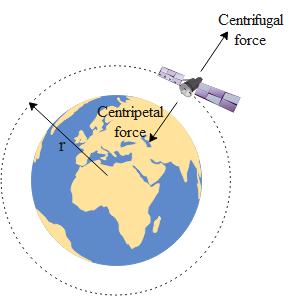
A satellite revolving around in the orbit of the Earth at a radius r and velocity v. If the radius of the orbit becomes doubled. Find out its new velocity.
$\begin{align}
& a)v/2 \\
& b)v/\sqrt{2} \\
& c)v \\
& d)\sqrt{2}v \\
& e)2v \\
\end{align}$
Answer
479.1k+ views
Hint: Satellites in each orbit of different radius R travel with different velocities. This is because the centrifugal force at every point as we go away from the earth the centrifugal force is overcome by less and less centripetal force. Hence from the centripetal force the orbital velocity for a satellite is given by, $v=\sqrt{\dfrac{GM}{r}}$ where G is the gravitational constant, M is the mass of the Earth and r is the radius of the orbit from the centre of the Earth.
Complete step by step answer:
Let us consider a satellite orbiting the earth at radius r as shown in the figure.

The orbital velocity of the above satellite is given by,
$v=\sqrt{\dfrac{GM}{r}}m{{s}^{-1}}$ Now let us say we increase the radius of the orbit to 2r.Than the linear velocity (V)along the circumference of the orbit is given by,
$V=\sqrt{\dfrac{GM}{2r}}$ now let us write this obtained velocity of the satellite in terms of velocity of the velocity of the satellite orbiting the Earth at radius r.
$\begin{align}
& V=\sqrt{\dfrac{GM}{2r}} \\
& V=\dfrac{1}{\sqrt{2}}\left( \sqrt{\dfrac{GM}{r}} \right)\text{, }\sqrt{\dfrac{\text{GM}}{\text{r}}}\text{is the velocity }v,\text{hence} \\
& V=\dfrac{v}{\sqrt{2}}m{{s}^{-1}} \\
\end{align}$
So, the correct answer is “Option B”.
Note:
The orbital velocity of a satellite varies inversely with the radius. As we move far and far away from the centre of the Earth the orbital velocity of the satellite decreases. At a particular point the centripetal force will be so poor that the satellite at that particular distance from the centre of the Earth, won't orbit the planet anymore and will just move in space some with constant velocity.
Complete step by step answer:
Let us consider a satellite orbiting the earth at radius r as shown in the figure.

The orbital velocity of the above satellite is given by,
$v=\sqrt{\dfrac{GM}{r}}m{{s}^{-1}}$ Now let us say we increase the radius of the orbit to 2r.Than the linear velocity (V)along the circumference of the orbit is given by,
$V=\sqrt{\dfrac{GM}{2r}}$ now let us write this obtained velocity of the satellite in terms of velocity of the velocity of the satellite orbiting the Earth at radius r.
$\begin{align}
& V=\sqrt{\dfrac{GM}{2r}} \\
& V=\dfrac{1}{\sqrt{2}}\left( \sqrt{\dfrac{GM}{r}} \right)\text{, }\sqrt{\dfrac{\text{GM}}{\text{r}}}\text{is the velocity }v,\text{hence} \\
& V=\dfrac{v}{\sqrt{2}}m{{s}^{-1}} \\
\end{align}$
So, the correct answer is “Option B”.
Note:
The orbital velocity of a satellite varies inversely with the radius. As we move far and far away from the centre of the Earth the orbital velocity of the satellite decreases. At a particular point the centripetal force will be so poor that the satellite at that particular distance from the centre of the Earth, won't orbit the planet anymore and will just move in space some with constant velocity.
Recently Updated Pages
Glucose when reduced with HI and red Phosphorus gives class 11 chemistry CBSE

The highest possible oxidation states of Uranium and class 11 chemistry CBSE

Find the value of x if the mode of the following data class 11 maths CBSE

Which of the following can be used in the Friedel Crafts class 11 chemistry CBSE

A sphere of mass 40 kg is attracted by a second sphere class 11 physics CBSE

Statement I Reactivity of aluminium decreases when class 11 chemistry CBSE

Trending doubts
10 examples of friction in our daily life

The correct order of melting point of 14th group elements class 11 chemistry CBSE

Difference Between Prokaryotic Cells and Eukaryotic Cells

One Metric ton is equal to kg A 10000 B 1000 C 100 class 11 physics CBSE

State and prove Bernoullis theorem class 11 physics CBSE

What organs are located on the left side of your body class 11 biology CBSE




